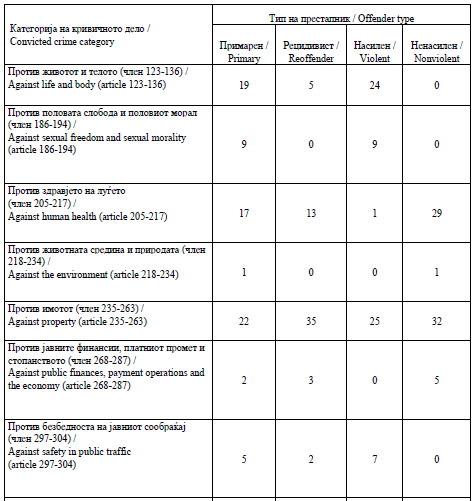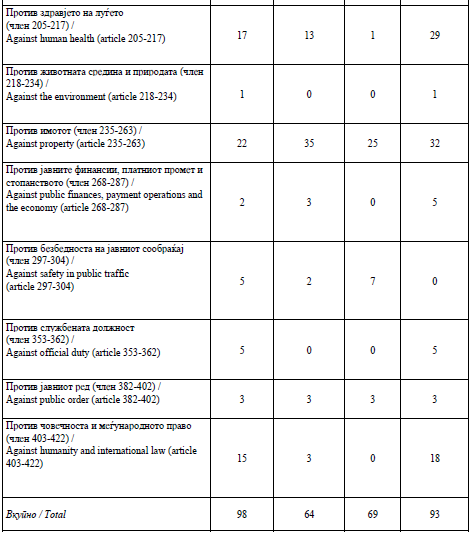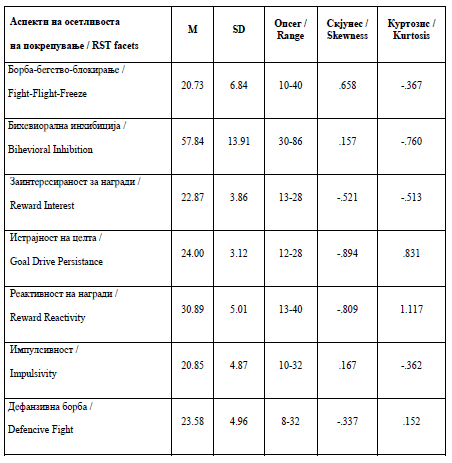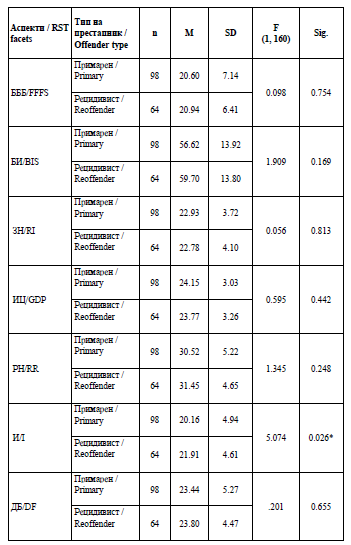JSER Policies
JSER Online
JSER Data
Frequency: quarterly
ISSN: 1409-6099 (Print)
ISSN: 1857-663X (Online)
Authors Info
- Read: 27848
|
ОСЕТЛИВОСТ НА ПОТКРЕПУВАЊЕ КАЈ
РЕЦИДИВИСТИ И НАСИЛНИ ПРЕСТАПНИЦИ
Зоран КИТКАЊ1
Катерина НАУМОВА2
|
REINFORCEMENT SENSITIVITY
IN REOFFENDERS AND VIOLENT OFFENDERS
Zoran KITKANJ1
Katerina NAUMOVA2
|
|
ВОВЕД
|
INTRODUCTION
The relationship between personality and crime has
been vastly investigated in theoretical and empirical
studies in different scientific domains. Over the years
various scientific theories have emerged in an effort to
elaborate the importance of individual differences in
personality as predisposing factors of antisocial
behaviour and criminal offending, but also as potential
predictors of the effectiveness of offender
resocialization and prison treatment programs.
Among the numerous psychological perspectives on
antisocial and criminal behaviour (1), the
Reinforcement Sensitivity Theory (RST) has recently
sparked increasing research interest. RST represents a
neuropsychological model of personality, developed by
psychologist Jeffrey Gray (2,3), and based upon
individual differences in reactions to punishing and
rewarding stimuli. The theory was substantially revised
in 2000 by Gray and McNaughton (4). The revised
model proposes three principal motivation/emotion
systems: the Fight-Flight-Freeze System (FFFS), the
Behavioural Inhibition System (BIS) and the
Behavioural Approach System (BAS). RST thus
constitutes a theory of central emotion/motivational
states that mediate reactions to motivationally
significant (i.e., ‘reinforcing’) stimuli (5).
The Fight-Flight-Freeze System (FFFS) is responsible
for mediating fear reactions to aversive (threatening,
punishing or frustrating) stimuli, leading to avoidance
and escape behaviours or attempted elimination (anger
and attack). FFFS activity reduces the discrepancy
between the immediate threat and the desired state (i.e.,
safety). An associated personality factor with this
system comprises fear-proneness and avoidance.
The Behavioural Inhibition System (BIS) is responsible
for resolving different types of goal conflicts when
facing desired but also potentially threatening stimuli.
This system generates the emotion of anxiety, that is
primarily involved in inhibition of conflicting
behaviours and risk assessment. The BIS increases the
negative valence of stimuli, until a behavioural
resolution occurs manifested as approach or avoidance.
The associated personality factor comprises worry proneness and anxious rumination, resulting in a
constant state of looking-out for possible signs of
danger. Underactive BIS leads to risk proneness (e.g.,
psychopathy) while overactive BIS leads to risk
aversion (generalized anxiety). Both conditions
encompass sub-optimal conflict resolution. The BIS
serves several functions: it interrupts ongoing
behaviour (it inhibits ongoing appetitively and
aversively-motivated behaviours); it initiates ‘passive
avoidance’, i.e. cautious approach and risk assessment
aimed at gathering information on the threat posed by
the environment or, in some situations, withholding
from entry into a threatening environment. Other
processes associated with the BIS, are worry and
rumination about possible danger; obsessive thoughts
about the possibility of something unpleasant
happening; and behavioural disengagement, when the
threat is unavoidable.
The Behavioural Approach System (BAS) mediates
reactions to appetitive stimuli. This system generates
the emotion of ‘anticipatory pleasure’. The associated
personality factor comprises optimism, reward
orientation and impulsiveness. An overactive BAS
delineates a disposition toward addictive, high-risk and
impulsive patterns of behaviour. Corr (5) proposes a
multidimensional conceptualization of distinct but
related BAS processes: Reward Interest represents the
initial motivation to seek out potentially rewarding places, activities and people; Goal Drive-Persistence
relates to actively pursuing desired goals, particularly
when immediate reward is not available; Reward-
Reactivity denotes the excitement and pleasure of
doing things well; and Impulsivity entails behaviours
closer to the final goal (reinforcer), when planning and
restraint of behaviour are no longer present.
According to RST, differences in human temperament
and reactivity can be explained by individual
differences in the functioning of the three systems and
their interaction (6). BAS and BIS are reciprocally
connected, each operating to inhibit behaviour
governed by the other. A balance between the systems
can be achieved only at low levels of activity in both.
Corr and McNaughton (7) point out that joint
activation of these systems increases arousal as a result
of conflicting motivations, resulting in subtractive
decision-making. However, one overactive system with
a deficient other poses a high risk for social adjustment
as well.
Empirical studies show that an overactive BIS leads to
social withdrawal and emotional distress and an
overactive BAS leads to risky, antisocial behaviour (8).
Dysinhibition, as a prominent feature of criminal
behaviour (9) can also result from an overactive BIS,
an underactive BIS, or a BAS that is more active than
the BIS (10). Research also shows that two BAS
dimensions, impulsivity and reward interest, are often
confirmed risk factors of antisocial and criminal
behaviour (11,12,13).
Studies also demonstrate that antisocial individuals are
less sensitive to punishment (underactive BIS) and
highly sensitive to rewards (overactive BAS). The
rewarding effect stems from the execution of the
offense (14). For example, Morgan, Bowen, Moore and
van Goozen (15) found higher BAS and lower BIS
sensitivity in male adolescent offenders as compared to
non-offenders. Bacon, Corr and Satchell (16) have
further found that antisocial behaviour is associated
with goal-drive persistence in males and impulsivity in
females. Investigating the associations between the
motivational systems and psychopathic tendencies,
Broerman, Ross and Corr (17) report that primary
psychopathy is negatively related to the BIS and the
FFFS, while positively related to BAS goal-drive persistence. Secondary psychopathy is positively
related to BAS impulsivity. The FFFS was found to be
incrementally predictive of primary but not secondary
psychopathy. Leue, Brocke, & Hoyer (18) compared
male sex offenders and non-offenders and found that
higher reward sensitivity, impulsivity and anxiety
discriminated the offenders from the non-offenders.
Previously mentioned studies on RST and crime have
mostly been focused on characteristics that distinguish
offenders from non-offenders. Less frequent is the
more refined comparison of offenders who have
committed different types of crimes. But as Canter and
Youngs (19) point out assigning offenders to a
particular type of criminality has to take into
consideration the context of the crime and the stage in
the offender’s criminal and psychological
development.
Considering the lack of empirical research in offending
subgroups our study aims to examine whether RST
facets can differentiate reoffenders from primary
offenders and violent from nonviolent offenders.
Method
Participants and procedure
The participants are male offenders (N=162)
incarcerated in three penitentiary institutions in
Macedonia: Penitentiary facilities Idrizovo and Stip,
and Kumanovo Prison. These are institutions with
largest accommodation capacities. The first two are
closed institutions, while the third one is semi-open.
The average age of the participants is 36 years (±10.5,
age range: 18-65), while the average age when they
committed the currently sanctioned offense is 31 years
(±9.9). Most of the offenders are Ethnic Macedonians
(77%), have secondary education (52%), were
employed prior to incarceration (74%) and are not
married (46%). As part of their resocialization process
most of the offenders (59%) have certain working
engagements inside the penitentiary facility. On
average, the duration of the prison sentence in the
sample is just over seven years (87 months, range: 6-
300 months, 3 offenders were serving a lifetime
sentence). Regarding offending type, 64 participants
are reoffenders (penal recidivists) and 69 are violent offenders. We used the official prison records to split
the offenders in groups. No significant differences
were detected regarding sociodemographic
characteristics in offender subgroups (age, education,
marital and previous work status). With respect to
criminological characteristics, the only significant
difference was detected between violent and nonviolent
offenders, regarding sentence length, which is
an expected finding due to the nature of the criminal
acts (Мv = 8.6 ± 4.9 years > Мnv = 6.3 ± 3.8 years , t
(117) = 3.27, p < 0.01). A detailed description of the
sample is provided in Table 1. with respect to
convicted crime categorization. The criminal acts were
categorized according to the Criminal Code of
R.Macedonia.
|
Табела 1. Структура на примерокот според категоријата на извршени кривични дела
Table 1. Sample structure according to convicted crime categorization


|
Податоците се прибирани во периодот август-сеп-
тември 2017 година преку интервјуа спроведени од
страна на членовите на тимовите за ресоцијализација (мал дел во нивно присуство од страна на еден од авторите на истражувањето). Не беа евидентирани индикатори на неискреност на испитаниците кои би предизвикале систематска грешка во мерењето. Само неколку испитаници беа исклучени од анализата поради некомплетни или невалидни одговори. Од сите испитаници е добиена информирана согласност за учество во истражувањето.
Мерни инструменти
Прашалник за процена на личноста според теори-
јата на осетливост на поткрепување (Reinforcement
Sensitivity Theory of Personality Questionnaire,
RST-PQ) (20). Станува збор за неодамна конструиран инструмент во согласност со ревидираниот модел на теоријата на осетливост на поткрепување, што се обидува да ги надмине различните слабости на претходно конструираните мерки поврзани со оваа теорија. Прашалникот се состои од 65 тврдења со кои се проценуваат четири домени на осетливоста на поткрепување. Одговарањето се врши со помош на четиристепена Ликертова скала на одговори, каде 1=воопшто не ме опишува, 2=малку ме опишува, 3=умерено ме опишува и 4=сосема ме опишува.
Првиот домен што се проценува со инструментот е
системот борба-бегство-блокирање што опфаќа
однесувања од типот бегство, блокирање и активно
избегнување. Оваа супскала се состои од 10 тврдења, а коефициентот на внатрешната конзистентност утврден во ова истражување е α = 0.81.
Вториот домен е системот на бихевиорална инхиби-
ција, во рамки на кој се прави дистинкција помеѓу
одбранбено приближување кон опасни стимули кои
може и кои не може да се избегнат. Како одговори на
опасни стимули што може да се избегнат вклучени се прекин на тековното однесување, бихевиорална процена на ризик и претпазливост и загриженост. Од
друга страна, како одговори на неизбежни опасни
стимули вклучени се опсесивни мисли и бихевиорал-
на неангажираност. Супскалата се состои од 23 твр-
дења, а Кронбах алфа-коефициентот во овој
примерок изнесува α = 0.91.
Третиот домен е системот на бихевиорална акти-
вација, што е операционализиран преку четири
компоненти: заинтересираност за награди, истрај-
ност во постигнувањето на цели, реактивност на награди и импулсивност. Преку заинтересираноста
за награди, се проценува отвореноста кон нови
искуства и можности кои потенцијално може да
предизвикаат задоволство (7 тврдења, α = 0.76). Ис-
трајноста во постигнувањето на цели ја проценува
мотивираноста да се дефинираат цели и нивни
компоненти кои водат до постигнување на одредена
награда, односно задоволство, што често пати може
да вклучува жртвување на краткотрајни или непо-
средни награди/задоволства, а истовремено опфаќа и одржување на долгорочна позитивна мотивираност
кога не е достапна непосредна награда (7 тврдења, α= 0.73). Реактивноста на награди го опфаќа генери-
рањето и доживувањето на награда (задоволство)
кога нештата се одвиваат во посакувана насока, што
овозможува позитивно поткрепување на однесува-
њето (10 тврдења, α = 0.78). Импулсивноста се
состои од отсуство на планирање и брзи реакции (8
тврдења, α = 0.71).
Авторите на овој прашалник, како дополнување на
трите системи, вметнале и дополнителна супскала,
како четврти домен на осетливоста на поткрепување,
а тоа е дефанзивната борба со која се проценуваат
бихевиорални реакции кога единката е соочена со
многу интензивна и непосредна закана и кога не се
возможни други можности за бегство (8 тврдења, α =
0.81).
Резултати
Во Табела 2 се прикажани дескриптивните статистики за сите супскали на користениот прашалник. Утврдена е умерена тенденција на групирање на податоците кон пониските оценки на супскалата борба бегство-блокирање, додека поистакната тенденција кон групирање на податоците кон повисоките оценки е утврдена на супскалите истрајност на целта и
реактивност на награди, како димензии на системот
на бихевиорална активација.
|
The data was collected during August and October in
2017 in a series of one-on-one interview sessions with
the members of the resocialization staff (a small
proportion in their presence by one of the study
authors). No indicators of participants’ dishonesty were
detected that could systematically affect the results.
Only few offenders were excluded from the analyses
due to missing or invalid responses. All participants
provided informed consent to participate in the study.
Measures
Reinforcement Sensitivity Theory of Personality
Questionnaire (RST-PQ) (20). This is a recently
developed instrument in alignment with the revised
RST model, specifically designed to address various
drawbacks of previous RST measures. It consists of
65 items measuring three thematic facets. A four-point
Likert-style scale is offered with the following
response options: not at all, slightly, moderately, and
highly, as a a response key to the question “How
accurately does each statement describe you?”
The first measured facet is the Fight-Flight-Freeze
System (FFFS) encompassing flight, freeze and active
avoidance behaviour. The subscale consists of 10
items and the internal consistency coefficient obtained
in this study is α = 0.81.
The second facet is the Behavioural Inhibition System
(BIS), that incorporates a distinction between
defensive approach to avoidable and unavoidable
dangerous stimuli. Motor interruption, behavioural
caution/risk assessment, and worry are assigned as
responses to avoidable dangerous stimuli, while
obsessional thoughts, and behavioural disengagement
are assigned as responses to unavoidable dangerous
stimuli. This subscale consists of 23 items and the
obtained Cronbach’s alpha in this study is α = 0.91.
The third facet is the Behavioural Approach System
(BAS), operationalized through four subcomponents:
Reward Interest, Goal-Drive Persistence, Reward
Reactivity, and Impulsivity. Reward Interest (RI)
measures openness to new experiences and
opportunities that are potentially rewarding (7 items, α
= 0.76). Goal-Drive Persistence (GDP) measures the
motivation to put in place goals and sub-goals to achieve an ultimate aim of obtaining a reward,
although often at the expense of a short-term or
immediate reward, as well as the maintenance of
positive motivation over time when an immediate
reward is not available (7 items, α = 0.73). Reward
Reactivity (RR) relates to the generation and
experience of reward (i.e., ‘pleasure’) when things are
going well and provides the positive reinforcement for
BAS behaviour (10 items, α = 0.78). Impulsivity (I)
consists of non-planning and fast reactions (8 items, α
= 0.71).
The authors of RST-PQ propose that an additional
factor should be included as a separate scale and a
fourth facet, i.e. Defensive Fight, that taps into
behavioural reactions when confronted with a high
intensity and immediate threat and when other forms
of escape are not available (8 items, α = 0.81)
Results
Table 2. presents descriptive statistics on all RST-PQ
scales. A moderate tendency of data grouping towards
lower scores is registered in the Fight-Flight-Freeze
System (FFFS) scale, while a more pronounced
tendency of data grouping towards higher scores is
registered in the Goal-Drive Persistence (GDP) and
Reward Reactivity (RR) scales as part of the
Behavioural Approach System (BAS).
|
Табела 2. Дескриптивни статистици за аспектите на осетливоста на поткрепување (N=162)
Table 2. Descriptive statistics for RST facets (N=162)

|
In order to assess the discriminant value of RST facets
in differentiating reoffenders from primary offenders
and violent from nonviolent offenders we used
univariate analysis of variance.
In the first analysis we compared reoffenders with
primary offenders (Table 3) and detected only one
significant difference between the groups in the
domain of the Behavioural Approach System (BAS).
Impulsivity (I) (i.e. non-planning and fast reactions)
was significantly more pronounced in reoffenders F
(1, 160) = 5.07, p < 0.05, g = 0.36.
|
Табела 3. Разлики во аспектите на осетливоста на поткрепување меѓу рецидивистите и примарните
престапници
Table 3. RST facets differences between reoffenders and primary offenders
Забелешка: БББ=систем борба-бегство-блокирање, БИ=систем на бихевиорална инхибиција,
ЗН=заинтересираност за награди, ИЦ=истрајност на целта, РН=реактивност на награди,
И=импулсивност, ДБ=дефанзивна борба
Note. FFFS = Fight-Flight-Freeze System; BIS=Bihevioral Inhibition System; RI=Reward Interest; GDP=Goal-Drive Persistence;
RR=Reward Reactivity; DF=Defensive Fight
* p < 0.05
Табела 4. Разлики во аспектите на осетливоста на поткрепување меѓу насилните и ненасилните
престапници
Table 4. RST facets differences between violent and nonviolent offenders

Забелешка: БББ=систем борба-бегство-блокирање, БИ=систем на бихевиорална инхибиција,
ЗН=заинтересираност за награди, ИЦ=истрајност на целта, РН=реактивност на награди,
И=импулсивност, ДБ=дефанзивна борба
Note. FFFS = Fight-Flight-Freeze System; BIS=Bihevioral Inhibition System; RI=Reward Interest; GDP=Goal-Drive Persistence;
RR=Reward Reactivity; DF=Defensive Fight
* p < 0.05
|
Во втората анализа беа споредувани насилните со
ненасилните престапници (Табела 4). И во овој случај се покажа дека насилните престапници се разликуваат од ненасилните само во однос на една димензија на системот на бихевиорална активација. Во овој случај, кај насилните престапници е утврдена значајно пониска заинтересираност за награди F (1, 160) = 3.99, p <0.05, g = 0.32 што ги одредува како помалку отворени за нови искуства и можности кои потенцијално може да предизвикаат задоволство.
Дискусија
Проучувањето на особините на личноста, концепту-
ализирани согласно со ревидираниот модел на тео-
ријата на осетливост на поткрепување, кај различни
групи престапници покажа дека само две димензии на системот на бихевиорална активација независно ги диференцираат повторните од примарните сторители,
односно насилните од ненасилните сторители.
Посилно истакнатата импулсивност кај рециди-
вистите е поврзана со слаба регулативна моќ на кон-
тролните механизми - когнитивни, емоционални
и/или бихевиорални, што ги предиспонира овие прес-
тапници кон рецидивизам. Иако овој аспект на
системот на бихевиорална активација се активира во
финалните фази од достигнувањето и консумирањето
на „наградата“, во ситуации кога е прекумерно акти-
вен, всушност може да го попречи реализирањето на
долгорочните цели. Крупиќ (Krupic) и Кор (Corr) (21)
ја нарекуваат оваа димензија „посакување“, дефи-
нирајќи ја како амбициозно тежнеење кон повеќе
ресурси и посакување на повеќе ресурси, при што
наведуваат емпириски наоди дека оваа црта е
поврзана со т.н. „брз стил на живот“, согласно со
теоријата на животната историја. „Брзите“ единки
според овој модел се повеќе ориентирани кон
експлоатирање на другите, повеќе се антисоцијално
насочени, храбри, активни, агресивни, помалку
дружељубиви, склони кон преземање ризици и
доминантни. Во контекст на ресоцијализацијата на
престапници со вакви особини, импулсивноста прет-
ставува ризик. Поради тоа, програмите за третман
треба да ги земат предвид специфичните стадиуми од криминалниот и психичкиот развој на престапникот, каде импулсивното однесување се појавува како деструктивен процес.
Кај насилните престапници, пак, беше утврдена по-
ниска заинтересираност за награди отколку кај
ненасилните престапници, што упатува на тоа дека кај нив постои послаба желба и тенденција за барање нови задоволства. Крупиќ (Krupic) и Кор (Corr) (21) го дефинираат овој аспект на системот на бихевиорална активација како ʼпоттикнувачка мотивацијаʻ.
Кога овој вид мотивација е послабо изразен, тоа
резултира со инхибирање на пристапот кон потен-
цијални задоволства (т.е. послаба проактивност).
Понатаму, тоа укажува и на послаба тенденција кон
когнитивно истражување и пониско изразена екстра-
верзија како мотивациска снага. Иако е маргинална
статистичката значајност на разликата меѓу престап-
ниците, сметаме дека е важна, не само во контекст на криминалитетот, туку и во контекст на ресоцијали-
зацијата. Заинтересираноста за награда е првиот че-
кор кон постигнување на зададена цел. Доколку ја
разгледуваме од аспект на примарни индивидуални
предиспозиции, извршувањето на насилен престап
повеќе е последица на контекстуални околности
отколку на силна желба за постигнување одредена
цел, при што, не смее да се занемари разновидната
природа на насилните престапи карактеристични за
оваа група испитаници. Кантер (Canter) и Јангc
(Youngs) (19) соодветно посочуваат на важноста на
наративното значење на криминалното дело за самиот престапник. Во отсуство на такви податоци можеме само да шпекулираме за потенцијалната улога на примарната мотивација. Од друга страна, неопходно е да се испита и можноста намалената заинтересираност за награди кај нив да претставува последица на корективната функција на процесот на ресоцијализација. Активноста на мотивациските системи влијае на можностите за стекнување нови животни искуства, меѓутоа и новите животни искуства влијаат на осетливоста на поткрепување. Оттука, уште повеќе се нагласува потребата од посветување дополнително внимание на индивидуалните разлики во посакувањето и пристапувањето кон потенцијални награди како субјективно перципирани компоненти на програмите за третман. Трета можност е да ги разгледаме овие наоди од аспект на особините на извршените кривични дела од страна на ненасилните престапници, кај кои е значајно поизразена заинтересираноста за награди. Во двете доминантни категории на дела поради кои им е изречена тековната затворска казна (против здравјето на луѓето и против имотот), всушност станува збор за производство/трговија со дроги/психотропни супстанци, односно кражби - два типа престапи кои имаат нагласен лукративeн ефект, односно јасно одредена апетитивна дразба. Иако наодите од ова истражување потврдуваат дека осетливоста на награди има подискриминативна
функција кај престапниците (11-14), отколку осетли-
воста на казни, исклучително е важно да се нагласи
дека податоците откриваат многу повеќе сличности
отколку разлики во особините на личност кај
споредуваните групи престапници. Тоа посочува на
неопходноста од дополнително проучување на
ефектите од искуствата поврзани со животот во
затворот, како фактори кои потенцијално посилно го
определуваат функционирањето на престапниците од примарните индивидуални предиспозиции. Со оглед на тоа што примерокот е хетероген во однос на видот на извршените кривични дела, но прилично хомоген согласно со постапката на избор на испитаниците вклучени се главно соработливи престапници, социјално адаптирани и работно ангажирани, чие однесување во текот на издржувањето на казната во најголем дел е проценето како позитивно - сметаме
дека следните истражувања во оваа област може да се фокусираат на споредба на престапници во однос на специфични кривични дела, а не на широки категории престапи, како и испитување на интеракцијата меѓу рецидивизмот и одделните категории престапи, земајќи ги предвид и криминогените потреби на затворениците. Ваквиот вид истражувања може да обезбедат насоки за подиференцирани и индивидуализирани форми на третман.
|
In the second analysis we compared violent with
nonviolent offenders (Table 4). Again, we detected
only one significant difference and it also encompasses
a feature of the Behavioural Approach System (BAS).
Reward Interest (RI) is significantly lower in violent
offenders F (1, 160) = 3.99, p < 0.05, g = 0.32 defining
them as less open to new experiences and opportunities
that are potentially rewarding in comparison to nonviolent
offenders.
Discussion
The investigation of personality traits as
conceptualized within the revised RST framework in
different types of offenders showed that the linear
combination of RST facets does not discriminate
reoffenders and violent offenders. Only two
dimensions of the BAS can independently differentiate
recidivism and violent offending.
Higher impulsivity in reoffenders relates to
dysregulated control mechanisms, either cognitive,
emotional and/or behavioural that predisposes them to
recidivism. Although this BAS aspect represents the
final stages of reward capturing and consummation,
when overactive it can actually inhibit the attainment
of long-term goals. Krupic & Corr (21) label this
dimension ‘wanting’, defining it as ambitious striving
and desiring more resources and offer empirical
evidence that this trait is associated with the so called
‘fast lifestyle’ according to the Life History Theory.
‘Fast’ individuals according to this model are more
exploitative/antisocial, bold, active, aggressive, less
sociable, impulsive, prone to risk-taking, and
dominant. In the context of resocialization impulsivity
poses a risk. Treatment programs should address the
specific stages both in the criminal and in the
psychological development process of the offender
where impulsive behaviour tends to occur as a
disruptive force.
The detected lower reward interest in violent offenders
suggest that they generally show a weaker desire and
tendency toward seeking new rewards. Krupic & Corr
(21) define this aspect of the BAS as ‘incentive
motivation’. Lower incentive motivation thus inhibits
the approach toward potential rewards (i.e. less might potentially determine offending behaviour more
significantly that primary personality dispositions.
Considering the heterogeneity of the sample with
respect to convicted crimes, as opposed to the
homogeneity with respect to participant recruitment -
mainly cooperative offenders were recruited, who are
socially adapted, have working engagements in the
facilities and whose behaviour was mainly assessed as
positive - we recommend that future studies should
focus on comparisons of perpetrators of specific
crimes, and not wide categories of offenses, as well as
on examining the interaction of recidivism and separate
offence types, accounting also for the criminogenic
needs of the offenders. These research approaches can
provide guidelines for differentiated and tailor made
types of treatment.
|
Литература / References:
1. Moore M. Psychological Theories of Crime and
Delinquency. Journal Of Human Behavior In The
Social Environment 2011; 21(3): 226-239.
2. Gray JA. The Neuropsychology of Anxiety: An
Enquiry into the Functions of the Septo-Hippocampal
System. Oxford: Oxford University Press, 1982.
3. Gray JA.The neurophysiology of temperament. Strelau
J, Angleitner A, eds. In: Explorations in temperament:
International perspectives on theory and measurement.
New York, NY: Plenum, 1991:105-128.
4. Gray JA, McNaughton N. The Neuropsychology of
Anxiety: An Enquiry into the Functions of the Septo-
Hippocampal System. Oxford: Oxford University
Press, 2000.
5. Corr P. Reinforcement Sensitivity Theory (RST):
Introduction. Corr P, ed. In: The reinforcement
sensitivity theory of personality. Cambridge, UK:
Cambridge University Press, 2008: 1-44.
6. Corr P, McNaughton N. Reinforcement Sensitivity
Theory and Personality. Corr P, ed. In: The
reinforcement sensitivity theory of personality.
Cambridge, UK: Cambridge University Press, 2008:
155-187.
7. Elovainio M, Kivimäki M. Models of personality and
health. Corr P, Matthews G, eds. In: The Cambridge
handbook of personality psychology. Cambridge, UK:
Cambridge University Press, 2009: 205-227.
8. Knyazev GD, Wilson GD, Slobodskaya HR.
Behavioural activation and inhibition in social
adjustment. Corr P, ed. In: The reinforcement
sensitivity theory of personality. Cambridge, UK:
Cambridge University Press, 2008: 415-430.
9. Wallace JF, Newman JP. RST and psychopathy:
associations between psychopathy and the behavioral
activation and inhibition systems. Corr P, ed. In: The
reinforcement sensitivity theory of personality.
Cambridge, UK: Cambridge University Press, 2008:
398-414.
10. Gomez, R. Personality and attention deficit
hyperactivity disorder. Corr P, Matthews G, eds. In:
The Cambridge handbook of personality psychology.
Cambridge, UK: Cambridge University Press, 2009:
704-716.
11. Hansen EB, Breivik G. Sensation seeking as a
predictor of positive and negative risk behaviour
among adolescents. Personality and Individual
Differences, 2001; 30: 627–640.
http://dx.doi.org/10.1016/S0191-8869(00)00061-1.
12. Maneiro L, Gómez-Fraguela JA, Cutrín O, Romero E.
Impulsivity traits as correlates of antisocial behaviour
in adolescents. Personality and Individual Differences,
2016; 104: 417–422.
http://dx.doi.org/10.1016/j.paid.2016.08.045.
13. Satchell L, Bacon A, Firth J, Corr P. Risk as reward:
Reinforcement sensitivity theory and psychopathic
personality perspectives on everyday risk-taking.
Personality and Individual Differences, 2018; 128:
162-169.
14. Fonseca A, Yule W. Personality and antisocial
behavior in children and adolescents: An enquiry into
Eysenck's and Gray's theories. Journal Of Abnormal
Child Psychology, 1995; 23(6): 767-781.
doi:10.1007/bf01447476
15. Morgan JE, Bowen KL, Moore SC, van Goozen SHM.
The relationship between reward and punishment
sensitivity and antisocial behavior in male adolescents.
Personality and Individual Differences, 2014; 63:122–
127. http://dx.doi.org/10.1016/j.paid.2014.01.054.
16. Bacon A, Corr P, Satchell L. A reinforcement
sensitivity theory explanation of antisocial behaviour.
Personality And Individual Differences, 2018; 123: 87-
93. http://dx.doi.org/10.1016/j.paid.2017.11.008
17. Broerman R, Ross S, Corr P. Throwing more light on
the dark side of psychopathy: An extension of previous
findings for the revised Reinforcement Sensitivity
Theory. Personality And Individual Differences, 2014;
68: 165-169. doi:10.1016/j.paid.2014.04.024
18. Leue A, Brocke B, Hoyer J. Reinforcement sensitivity
of sex offenders and non-offenders: An experimental
and psychometric study of reinforcement sensitivity
theory. British Journal of Psychology, 2008; 99: 361–
378.
19. Canter D, Youngs D. Personality and crime. Corr P,
Matthews G, eds. In: The Cambridge handbook of
personality psychology. Cambridge, UK: Cambridge
University Press, 2009: 780-798.
20. Corr PJ, Cooper AJ. The Reinforcement Sensitivity
Theory of Personality Questionnaire (RST-PQ):
Development and Validation. Psychological
Assessment, 2016; 28(11): 1427-144.
21. Krupić D, Corr P. Moving Forward with the BAS:
Towards a Neurobiology of Multidimensional Model
of Approach Motivation. Psihologijske Teme, 2017;
26(1): 25-45.
Share Us
Journal metrics
-
 SNIP 0.059
SNIP 0.059 -
 IPP 0.07
IPP 0.07 -
 SJR 0.13
SJR 0.13 -
 h5-index 7
h5-index 7 -
 Google-based impact factor: 0.68
Google-based impact factor: 0.68
10 Most Read Articles
- PARENTAL ACCEPTANCE / REJECTION AND EMOTIONAL INTELLIGENCE AMONG ADOLESCENTS WITH AND WITHOUT DELINQUENT BEHAVIOR
- RELATIONSHIP BETWEEN LIFE BUILDING SKILLS AND SOCIAL ADJUSTMENT OF STUDENTS WITH HEARING IMPAIRMENT: IMPLICATIONS FOR COUNSELING
- EXPERIENCES FROM THE EDUCATIONAL SYSTEM – NARRATIVES OF PARENTS WITH CHILDREN WITH DISABILITIES IN CROATIA
- INOVATIONS IN THERAPY OF AUTISM
- AUTISM AND TUBEROUS SCLEROSIS
- THE DURATION AND PHASES OF QUALITATIVE RESEARCH
- REHABILITATION OF PERSONS WITH CEREBRAL PALSY
- DISORDERED ATTENTION AS NEUROPSYCHOLOGICAL COGNITIVE DISFUNCTION
- HYPERACTIVE CHILD`S DISTURBED ATTENTION AS THE MOST COMMON CAUSE FOR LIGHT FORMS OF MENTAL DEFICIENCY
- DIAGNOSTIC AND TREATMENT OPTIONS IN AUTISTIC SPECTRUM DISORDERS – AN OVERVIEW

















